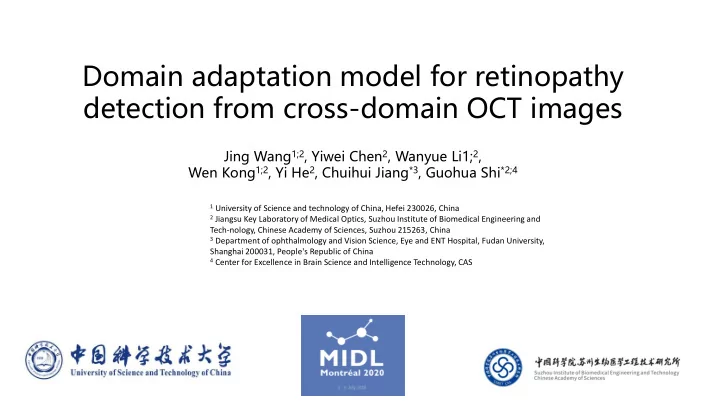

Domain adaptation model for retinopathy detection from cross-domain OCT images Jing Wang 1;2 , Yiwei Chen 2 , Wanyue Li1; 2 , Wen Kong 1;2 , Yi He 2 , Chuihui Jiang *3 , Guohua Shi *2;4 1 University of Science and technology of China, Hefei 230026, China 2 Jiangsu Key Laboratory of Medical Optics, Suzhou Institute of Biomedical Engineering and Tech-nology, Chinese Academy of Sciences, Suzhou 215263, China 3 Department of ophthalmology and Vision Science, Eye and ENT Hospital, Fudan University, Shanghai 200031, People's Republic of China 4 Center for Excellence in Brain Science and Intelligence Technology, CAS
Motivation • Classifier trained from one domain images perform badly on new domain images • Images captured from different devices have different signal distribution • D eep models’ performance declines when the test data are under a different distribution compared to the training data. • Labels of medical images are difficult to acquire. label ACC = 94.7% Source Image Source classifier ACC = 86.69% Source Image Target Image (without label)
Overview • Extracting the domain invariant and discriminative features to train the classifier. Source Label Source Classifier feature Feature Source Image Domain generator invariant Target feature test Target Image (without label)
Network architecture • An adversarial model was proposed to learn the domain invariant feature. • A Wasserstein estimator and an domain discriminator were combined to train the model
Result- cla lassifi fication across domain Table 1: Evaluation results (accuracy %) of several domain adaptation models on target datasets. (The evaluation results on the source dataset is reported in parentheses) Method MNIST -> USPS Ciruss -> Spectralis Source only 0.9612(0.9939) 0.8669(0.947) WDGRL 0.9756(0.9908) 0.9374(0.872) JDDA_CORAL 0.9314(0.9798) 0.9156(0.8671) JDDA_MMD 0.9368(0.985) 0.9255(0.8575) CADN 0.9696(0.9958) 0.8292(0.7223) DANN 0.9273(0.9953) 0.8699(0.6631) DAOCT(proposed) 0.9804(0.9914) 0.9553(0.9307)
Result-ablation experiment Table 3: Eectives of each key component in DAOCT, evaluation accuracy (%) on target dataset. 'FG' means feature gennerator proposed in this study, and multi-layer perceptron is set as default feature generator
Result-Tsne MNIST -> USPS Source domain Target domain (b) t-SNE of WDGRL (c) t-SNE of JDDA-MMD (d) t-SNE of DAOCT (a) t-SNE of Source-only Zeiss -> Heidberg Source domain Target domain (d) t-SNE of DAOCT (a) t-SNE of Source-only (b) t-SNE of WDGRL (c) t-SNE of JDDA-MMD
Future work • Combine this work with decoder to generate cross-domain images. [1] Segmentation, lesion detection … [1] Ucheli, et al. (2020).Biomedical optics express, 11 (1), 346 – 363.
Thank you
Recommend
More recommend